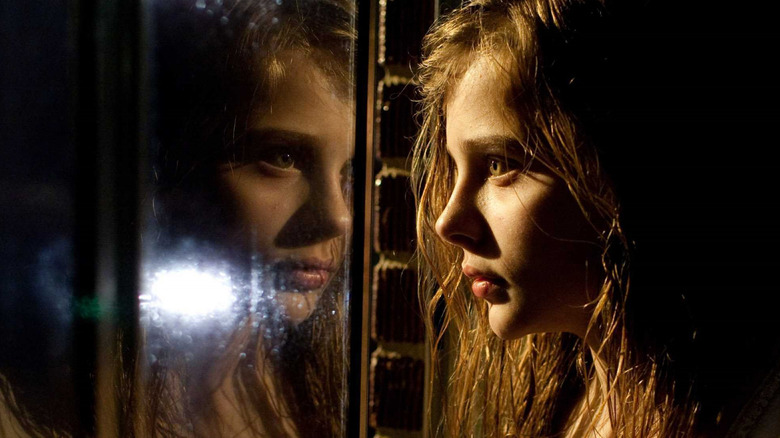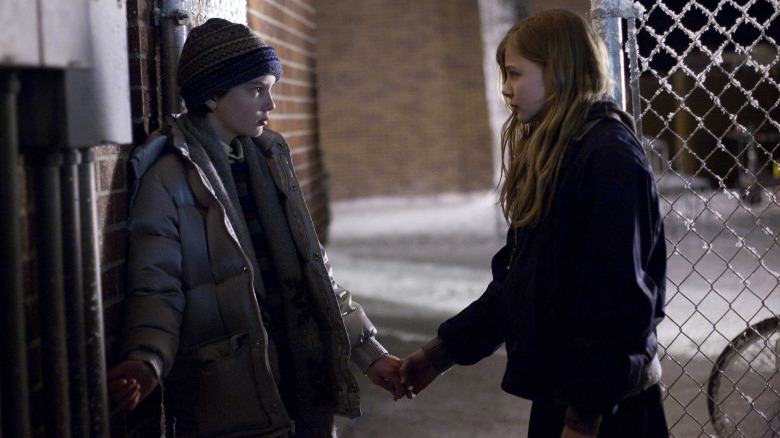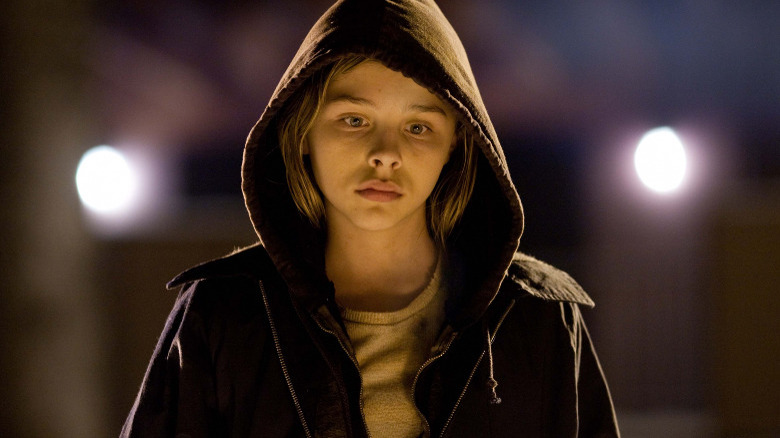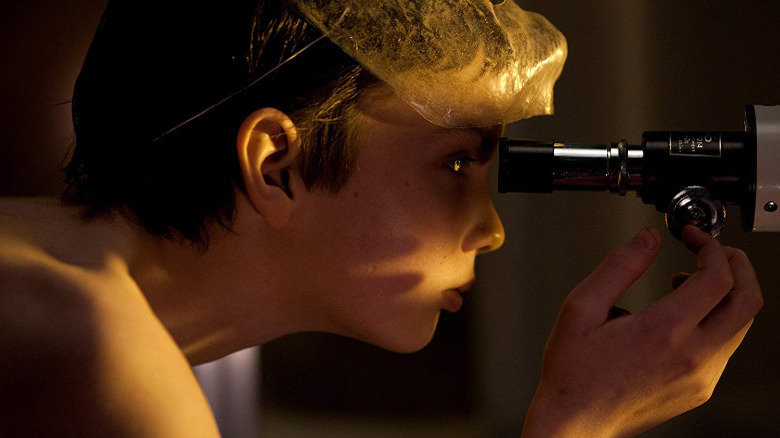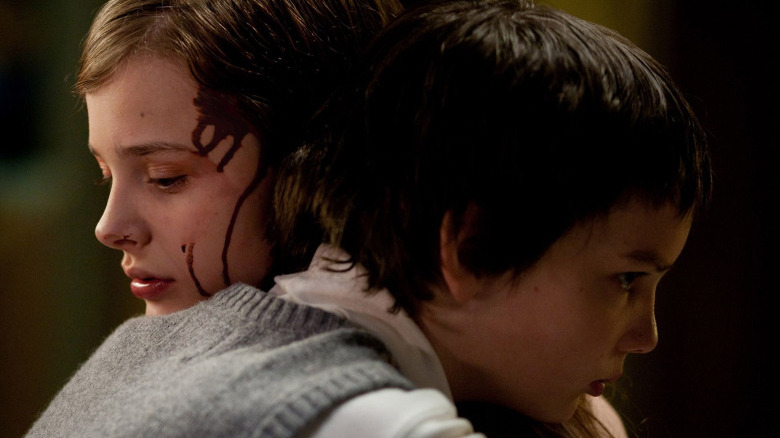How Matt Reeves Avoided Making A Copy-Paste Remake With Let Me In
As a general rule of thumb, U.S. remakes of non-American films are a bad idea. They rarely seem to measure up to the movies that came before them, and even when they do, it can be hard for them to escape their predecessor's shadow, no matter how well they stand on their own. Yes, there are some major exceptions to this rule — hello, "The Departed"!
Such is the case with "Cloverfield" and "The Batman" filmmaker Matt Reeves' "Let Me In," a mostly respected yet somewhat under-appreciated 2010 U.S. remake of director Tomas Alfredson's revered 2008 Swedish horror drama "Let the Right One In." The movies share the same basic plot: A bullied, lonely 12-year old boy befriends a vampire, initially believing them to be a girl his age. In both cases, the boy's discovery of the truth gives rise to a deeply melancholic and often disturbing coming-of-age story, yet also one that speaks to the universal experience of growing up and learning the world is far more complicated than one realized.
You may've already pieced together that I enjoy both films, as identical as they are in many respects. They are also quite different in other ways, not least of all in terms of their respective 1980s settings (Stockholm, Sweden, and Los Alamos, New Mexico) and the way they visualize their moments of horror, vampire-related or otherwise. You can chalk that up to Reeves, who only agreed to make "Let Me In" after forming a strong emotional bond to the non-genre elements at the heart of Alfredson's movie.
Reeves 'felt a responsibility' to make it
For those not aware, "Let the Right One In" is based on the novel of the same name by John Ajvide Lindqvist, who also penned the film's script. It was actually Lindqvist who encouraged Reeves to tackle "Let Me In" after the latter contacted him, having already seen Alfredson's movie and read the original book by that point.
As Reeves explained to DVD Talk:
"... I guess, I was so connected to that coming-of-age story [in 'Let the Right One In']. I actually reached out to Lindvist and said to him, 'I know that you know about the idea that [their] might be a remake and I have really been drawn to it — not because it's an amazing genre story, which it is, but because I was very moved by the coming-of-age story.' He wrote back to me and said he was excited I was involved because he loved 'Cloverfield' and how he liked I was drawn to it for personal reasons because it was a story from his childhood. At that point, I felt a responsibility."
The filmmaker continued, explaining that he "wanted to find ways to remain very true to the details and the shape" of the relationship between the main characters in "Let the Right One In" — Oskar (the 12-year-old boy) and Eli (the older vampire who looks like a child) — while also bringing "some of my own personal memories and my own personal context of growing up" to the table. This is why he carried the '80s backdrop for "Let the Right One In" over to "Let Me In," having himself grown up in Ronald Reagan's America during that decade. (Just to clarify: Reeves was born in 1966, meaning he was a few years older than Oskar by the time the '80s rolled around.)
Vampires and Reagan's America
"Let Me In" nods directly to the '80s' conservative political climate in its opening minutes, with Reagan shown delivering his infamous "Evil Empire" speech on a hospital TV set. For Reeves, this was more than just a way of establishing when, exactly, the movie takes place; it was a way of making it easier for the audience to understand where the movie's version of Oskar, renamed Owen (Kodi Smit-McPhee), was coming from and how it affected his desire for revenge against his tormentors at school.
Here's how he broke it down in a 2010 interview with Emmanuel Levy:
"I was very concerned with finding ways to translate this story from 1980s Sweden to 1980s America — which was Reagan America. The Cold War was still at its height when Ronald Reagan gave his 'Evil Empire' speech, and the president was telling the country that evil was something that existed outside of us — the Soviets were evil, but as Americans, we were fundamentally 'good.' And I thought to myself, what would it be like for a 12-year-old like Owen, who was harboring all these very dark feelings deep inside, to grow up in that context? It would be terribly confusing."
In doing this, "Let Me In" introduces a political subtext that isn't present in "Let the Right One In," further setting the two movies apart. What's more, it goes on to subtly critique the reactionary politics of the Reagan-era with a sub-plot involving "The Policeman," a nameless detective who hunts down its version of the Eli character (Abby, as played by Chloë Grace Moretz). This element come straight out of Lindqvist's source material but wasn't present in the Swedish-language film adaptation.
That wasn't by accident, either, as Reeves explained to DVD Talk:
"I also wanted to take certain elements from the book that weren't necessarily in Alfredson's film, like The Policeman. I wanted to use him in a way to heighten the Romeo and Juliet relationship that Owen and Abby have. I saw him as Tommy Lee Jones' character in 'No Country for Old Men,' where he feels like he's seen everything, but not this. In the eighties, there was a lot of talk of satanism and the satanic panic, and I thought that'd be a way of him relating to this. When you peel the layers back the story is so much about humanity."
The non-vampire next door
There are, of course, elements of Lindqvist's "Let the Right One In" novel (which is 480 pages long) that didn't make it into either film adaptation. "If you truly put all of the sub-plots from the novel in the movie and gave them the full weight, it'd be like a 10 hour miniseries," Reeves argued. Others, however, were tweaked in an effort to better condense the story to fit a two-hour film, including a sub-plot involving a woman named Virginia.
In that particular case, Reeves decided he "wanted to change the point-of-view slightly to even more of Owen's view." He even drew inspiration from a classic Alfred Hitchcock thriller:
"... I wanted to in telling the coming-of-age story use the sub-plots, like Virginia, who has this whole tragic sub-plot with her boyfriend, I wanted to instead use that character's life to be someone that Owen sees in a 'Rear Window'-esque way that illuminates the coming-of-age. She represents the world of adults and his first glimpse of sexuality. He sees two people fighting that probably reminds him of his own parents fighting and he's drawn to the world of adulthood, but also afraid of it."
Reeves added that he once again reached out to Lindqvist to let him know "the film was getting more and more into Owen's point of view and that Virginia was going to be a different type of character." As before, though, Lindqvist was supportive of Reeves, voicing his hope that he would include an element from Virginia's sub-plot in his book that didn't make the cut in Alfredson's "Let the Right One In" movie adaptation. (I'll refrain from spoiling it here, other than to note that Reeves called it "a great horror conceit.")
'We made it as a labor of love'
Lastly, but certainly not least of all, Reeves revealed the actors and other creatives on "Let Me In" didn't watch the "Let the Right One In" film adaptation prior to production, to avoid coloring their interpretation of the story and characters:
"My cast hadn't seen the film, my DP hadn't seen the film, and I felt it was really important that none of them watch it and that we make this movie as if it's its own thing. We made it as a labor of love. It's not like we sat out there trying to copy anything. We wanted to be faithful to the story and that's what led us. I felt if we could do that then I felt like we would have a chance of doing something worthwhile."
This explains why "Let Me In" has the same distinct look and feel as Reeves' other movies, from its somber yet striking color palette and nighttime lighting (courtesy of director of photography Greig Fraser, who would go on to reunite with Reeves on "The Batman") to a brutal car crash scene that, in hindsight, almost comes across as a low-budget test run for the huge set pieces in the filmmaker's later blockbusters. Add it to the many small-but-meaningful story changes Reeves made, and the result is a visceral, unsettling, and even moving vampire drama that arguably deserves more respect than it gets, whether you still prefer "Let the Right One In" or not.
